
Matthew McDowell was a steamboat owner and builder associated with the Puget Sound Mosquito Fleet.

Matthew McDowell was a steamboat owner and builder associated with the Puget Sound Mosquito Fleet.
McDowell was born in Glasgow, Scotland, and left home at age 15 to work as a coal passer for steamers of the Anchor Line. He had three sons and one daughter, all of whom were associated with his steamboat business. His three sons Albert(George Alexander), Robert, and John served as engineers and eventually all qualified as masters. His daughter Mary acted as purser. Mary later married Arthur Thompson, who became a well-known Puget Sound pilot. [1]
McDowell's fleet was originally based in Tacoma near the smelter. He often slept on one of his boats, especially if he was to be its captain the following morning. Once a vessel he was sleeping in was nearly run down by a large steamer, so in 1905 Captain McDowell bought 80 acres (320,000 m2) of land on Browns Point.
McDowell built a house and dock near the lighthouse. He called his new home Caledonia, after the poetic name for Scotland. His boats served landings Dumas Bay, Lakota, Adelaide, Redondo, Des Moines, Zenith, Maury, Portage, Chautauqua, Vashon Island, Tacoma and Seattle. As the permanent population and the summer vacationers increased, his business thrived. He later built a dance hall next to his dock, and transported patrons to it on the D fleet steamers. [2]
In early 1890s, McDowell operated the propeller steamer Quickstep (built at Astoria in 1877) as a towboat on Puget Sound. [3]
In 1897, McDowell built his first boat. Defiance (I), at Caledonia, near Tacoma. She was 60.5 long and rated at 85 tons. Defiance (I) was the first of six steamboats launched by Captain McDowell, all beginning with the letter "D" and all built at the Crawford and Reid ship yard. In each case, Captain McDowell took personal charge of the construction. [3]
Boats built or reconstructed by Captain McDowell for his "D Fleet" included
The D Fleet also is reported to have operated Monticello (built 1906). [4]
Ready sources do not give much information on the later days of Captain McDowell. The webpage of a local historical society states that Captain McDowell anticipated a decline in passenger business as the demand grew for automobile ferries, and began selling his fleet in 1918 while steamers were still in demand, retiring completely from the steamer service in August 1919. [2] It is known that he lived to at least the age of 94 years. He died in Tacoma in December, 1944.
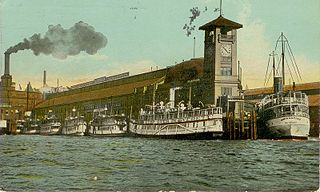
The Puget Sound mosquito fleet was a large number of private transportation companies running smaller passenger and freight boats on Puget Sound and nearby waterways and rivers. This large group of steamers and sternwheelers plied the waters of Puget Sound, stopping at every waterfront dock. The historical period defining the beginning and end of the mosquito fleet is ambiguous, but the peak of activity occurred between the First and Second World Wars.

Lake Washington steamboats and ferries operated from about 1875 to 1951, transporting passengers, vehicles and freight across Lake Washington, a large lake to the east of Seattle, Washington. Before modern highways and bridges were built, the only means of crossing the lake, other than the traditional canoe or rowboat, was by steamboat, and, later, by ferry. While there was no easily navigable connection to Puget Sound, the Lake Washington Ship Canal now connects Lake Washington to Lake Union, and from there Puget Sound is reached by way of the Hiram M. Chittenden Locks.

The sternwheeler Multnomah was built at East Portland, Oregon in 1885 and operated on the Willamette and Columbia Rivers until 1889 in the United States. She was later transferred to Puget Sound and became one of the better known steamboats operating there.

The Hunt Brothers were the owners of a steamboat business that ran on Puget Sound as part of the Puget Sound Mosquito Fleet. Five of the seven Hunt children became owners, engineers and masters of steamboats, these were Emmett E., Arthur.M., A.R, L.B., and F.M. Hunt.
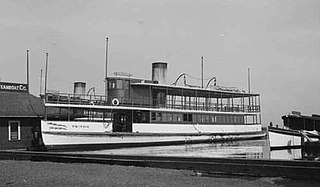
The steamboat Triton was a vessel that operated on Lake Washington in the first part of the 20th century.

The steamboat Fortuna was a vessel that operated on Lake Washington in the first part of the 20th century.
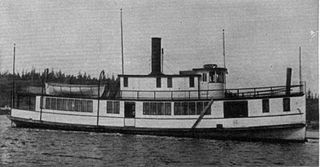
Not to be confused with the Virginia III (ex-Typhoon)

The steamboat Defiance operated in the early 1900s as part of the Puget Sound Mosquito Fleet. In later years this vessel was called Kingston.
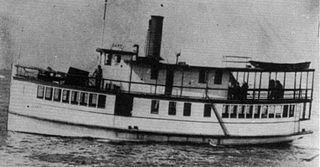
The steamboat Dart operated in the early 1900s as part of the Puget Sound Mosquito Fleet.

The steamboat Dauntless operated in the early 1900s as part of the Puget Sound Mosquito Fleet.

The steamboat Daily operated in the early 1900s as part of the Puget Sound Mosquito Fleet. In later years, Daily was renamed Island Princess and later Cy Peck.

The steamboat Monticello (2) operated in the early 1900s as part of the Puget Sound Mosquito Fleet. The vessel went through several reconstructions and remained in service until 1962, when she was lost in Alaska waters. Her later names were Penaco and Sea Venture. (This Puget Sound steamer should not be confused with the smaller Monticello, which also ran on Puget Sound, but was built in 1895 for Captain Z.J. Hatch of the Monticello Steamship Company.

The steamboat Crystal operated in the early 1900s as part of the Puget Sound Mosquito Fleet.

The steamboat Fleetwood operated in the 1880s and 1890s on the Columbia River and later as part of the Puget Sound Mosquito Fleet.

The steamboat Dix operated from 1904 to 1906 as part of the Puget Sound Mosquito Fleet. She was sunk in a collision which remains one of the most serious transportation accidents in the state of Washington to this day.

Tacoma was a steamship that served from 1913 to 1938 on Puget Sound. Built of steel, Tacoma was known for being one of the fastest and best-designed vessels to operate on Puget Sound. Tacoma was particularly noted for high-speed service from 1913 to 1930 on the route between Tacoma and Seattle.
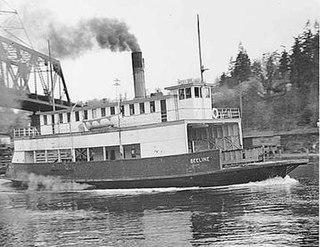
Florence K was a steamboat that was operated on Puget Sound from 1903. This vessel was later renamed Gloria and was rebuilt as a steam ferry and renamed Beeline.

Inland Flyer was a passenger steamboat that ran on Puget Sound from 1898 to 1916. From 1910 to 1916 this vessel was known as the Mohawk. The vessel is notable as the first steamer on Puget Sound to use oil fuel. Inland Flyer was one of the most famous vessels of the time on Puget Sound.

Concordia was a steamboat that ran on Puget Sound from 1930 to 1976. Although later converted to diesel power, Concordia was the last inland commercial steamboat ever built on either Puget Sound or the Columbia river.
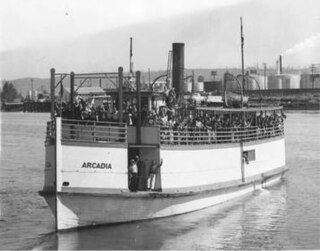
The steamboat Arcadia, built in 1929, was one of the last commercial steamboats placed into service on Puget Sound. The vessel later served as a prison tender under the name J.E. Overlade, and after that, as Virginia VI, as an excursion vessel.